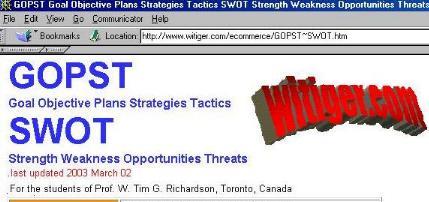
CCT 322

CCT 322 |
Marketing Information Products & Services |
| Section A | Section B | Section C | Section D | Section E |
|
| The key to developing
a "Marketing Orientation" is that
Customer Satisfaction is the Focus o what drives customer satisfaction (discussed on page 8)
|
|
Chapter 1 
page 15-17 Product Focus
|
The Evolution
of Marketing Thinking
bottom of page 15 o Product Focus o Sales Orientation o Customer Focus (Marketing Orientation) o Product Focus
|
|
Chapter 1 
page 15-17 Product Focus
|
The Evolution
of Marketing Thinking
o Customer Focus (Marketing Orientation)
o
Retention
|
Chapter
1

page 25 |
Before beginning
this course it is important to address the fundamental question of
"Is marketing important?" Well, if you are selling a product or service, and there is no competition, then marketing is not too important cause the customers have no choice but to buy your stuff - but, if the competitive environment" is intense - then the customers have a lot of choice; - so you'll have to do some marketing to be successful, otherwise nobody will have heard about your product and you will have no sales. So,... the first thing we deal with is the fact that the degree of intensity in the competitive environment has an effect on the degree to which a compant does, or does not have a big marketing campaign. Some good examples in 2004 of which there are intense marketing campaigns, because there are many companies making the product o DVD players |
|
Chapter 2  |
The things you cannot
do anything about are the 6 environments
These environments are the constraints within which marketing exists
|
|
|
In international
business, dealing with the 6 environments are critical to developing your
4P's
http://www.witiger.com/internationalbusiness/6environments.htm - we will look at a this unit in CCT322 because some of the explanations of the environments can apply to Marketing Information Products & Services |
 |
Marketing Strategy composed of 1 - Target Market - a group of homogenous customers 2 - Marketing Mix (the marketing mix being the 4 p's) - page 6 - the controllable variables - the things you can do something about |
|
Chapter 2 Strategic Company Planning 
p. 44-45 |
.
 .
. |
| Key Points | Mission Statements
are different than Goals.
Goals are usually something expressed in terms of Corporate Planning and serve the purpose of trying to identify where we are headed and how do we know if we get there. Goals are something that can be achieved if you satisfy certain Objectives. Mission Statements serve a more "public" purpose of having a slogan for employees and customers so that the company is able to say something that motivates employees and makes customers think they are a social responsible firm with a great product. In truth, many large companies have Mission statements which the employees mock, and customers are sceptical about. Unless the phrase is genuinely sincere, it is better in our jaded times to not emphasize a Mission Statement because you leave yourself open to ridicule and sarcasm. WTGR |
|
Chapter 2  |
SWOT,
page 46 text see www.witiger.com/ecommerce/GOPST~SWOT.htm
|
| The Marketing Plan
- part of the Marketing Strategy - part of the Marketing Program
- Chapter 2 page 42 in text

.
|

Chapter 2
|
the following text comes from the Sept 23rd, 2002 story "Marketing strategies for start-up businesses are hit-and-miss affairs. Unfortunately for a large percentage of those businesses, it is more miss than hit. Up to 40% of Canadian businesses fail in their first year. By year four, that rate has jumped to as high as 70%, according to Statistics Canada. Key among the reasons behind business failure is marketing." "David Frey, president of
Marketing Best Practices Inc., of Houston, Tex., says it should be the
first element of any business plan. "Your marketing plan is where you prove
your concept," he says.
What competition will I face and how will those companies respond? If you can't sell it, you shouldn't produce it," he says.
A marketing plan is "a recipe for getting it right," Ms. Bishop says. That recipe should include goals, marketing tactics and specific actions to execute both. .
"It should be aimed at a
specific customer and be grounded in sound research."
The key is to listen to the customer, to what the marketplace is saying and to what the competition is saying. "Your business ultimately depends, not on customer satisfaction but on having them return as loyal customers."
|
| SBUs Strategic Business
Units
p. 52 Chpt 2 SBUs are created for more effective planning and focus. In the screen capture below
from Goodyear, we can see they clearly define their SBUs
- WTGR says sometimes SBUs
are created by CEOs for the purpose of internal competition - to force
competition within the large corporation which may in the future lead to
decisions about which units to cut and which to grow
|
|
Chapter 2  |
Determine Marketing Objectives,
p. 47
(also called the Product-Market Growth Matrix on bottom of page 55-56) Types of Opportunities
to pursue -
- Market Penetration
|
.
.
|
|
CONTACT I MAIN PAGE I NEWS GALLERY I E-BIZ SHORTCUTS I INT'L BIZ SHORTCUTS I MKTG&BUSINESS SHORTCUTS I TEACHING SCHEDULE |
| . | |
| MISTAKES I TEXTS USED I IMAGES I RANK I DISCLAIMER I STUDENT CONTRIBUTORS I FORMER STUDENTS I | |
| . |